Enchanted Animals, Padlocked Lips
By Stephen Brookes
The Washington Post • August 20, 2007
The Wolf Trap Opera Company has an abiding affection for "The Magic Flute," Mozart's last opera and one of his most popular. The company has put it on six times over the years, and little wonder -- with its enchanted animals, kidnapped princess, padlocked lips and so on, it's a perfect fairy tale for a summer evening. Wolf Trap made things even more magical over the weekend by pricing lawn seats at only $8; the view may not have been perfect, but the music upstaged the acting anyway. And to lie on your back, staring up into the stars while the Queen of the Night unleashes her fury? A bargain at any price. Director Stanley M. Garner rightly tried to downplay the more arcane aspects of the opera (Mozart filled it with references to Freemasonry, most of them lost on contemporary audiences) and focus on the fantastical. But it was still a rather measured, low-key production, not nearly as playful as it could have been, despite a fine comic turn by baritone Liam Bonner -- who overcame his pink tights and lime-green man-bag to turn in a funny, free-spirited performance as the bird-catcher Papageno.
Director Stanley M. Garner rightly tried to downplay the more arcane aspects of the opera (Mozart filled it with references to Freemasonry, most of them lost on contemporary audiences) and focus on the fantastical. But it was still a rather measured, low-key production, not nearly as playful as it could have been, despite a fine comic turn by baritone Liam Bonner -- who overcame his pink tights and lime-green man-bag to turn in a funny, free-spirited performance as the bird-catcher Papageno.
Conductor Robert Wood kept the music moving at an energetic clip, though, and soprano Rebekah Camm brought both brainpower and an unfailingly gorgeous voice to the role of Pamina, lighting up the stage every time she appeared. Things dimmed a bit, though, whenever tenor Beau Gibson appeared as the noble Tamino; while he sang well enough, he ambled through his various challenges with all the dramatic punch of a quart of milk. But South African soprano Bronwen Forbay showed what a brilliant Queen of the Night she can be, nailing the nerve-racking aria "Der Hoelle Rache" with delectable ferocity -- and proving that Mozart's strange magic lives on.
Monheit's Dilemma
By Stephen Brookes
The Washington Post • August 13, 2007
Jane Monheit has one of those protean voices that, it seems, can do whatever it wants. It can steam into a sultry ballad, drift smokily around a Brazilian samba, scat through a driving jazz number and even bring done-to-death standards back to life. It’s so versatile you could probably send the damn thing to the UN, sit back for an hour, and watch it put an end to world hunger.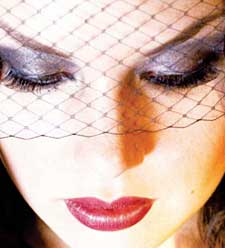 But Monheit’s dilemma is how to find a voice of her own in that amazing range. And as she showed at the Birchmere on Friday night, she’s still looking.
But Monheit’s dilemma is how to find a voice of her own in that amazing range. And as she showed at the Birchmere on Friday night, she’s still looking.
Since bursting onto the scene in 2000 with the jazzy “Never Never Land,” Monheit’s been dipping her toe in everywhere: a little cabaret, a little pop, and most recently (with this year’s Brazilian-flavored “Surrender”) a lot of bossa nova. So it wasn’t too surprising that Friday’s concert was a smorgasbord, with everything from Stevie Wonder’s “Overjoyed” to a breakneck version of that Annie Ross classic, “Twisted.” Backed by an able but low-key five piece band, Monheit was in fine form, and turned in near-perfect accounts of numbers like Harold Arlen’s “Between the Devil and the Deep Blue Sea” (in an arrangement by her pianist, Michael Kanan) and the Sergio Mendes song, “So Many Stars.”
Elsewhere, though, things sometimes got a bit overcooked. A teary-cheeked account of “Moon River” pretty much flooded its banks, and Peggy Lee’s dark, edgy “The Shining Sea” just sounded confused – Monheit may be most convincing when she keeps to shallower waters. But her forays into Brazilian music fared better. She obviously loves this material, and brought off Ivan Lins’ “Rio de Maio” and Antonio Carlos Jobim’s “So Tinha De Ser Com Voce” with style and a kind of nice-girl sexiness. Is this where she’s found her true voice? Maybe – but stay tuned. Monheit’s wanderings probably aren’t over yet.
The iPod in the Concert Hall
By Stephen Brookes
The Washington Post • August 4, 2007
It was enough to make any music purist run screaming back to the Victrola.
As conductor Emil de Cou took the podium at Wolf Trap on Thursday night, he urged the audience to put on headphones, switch on their iPods and settle in for an evening of -- shudder -- music video from the National Symphony Orchestra.
The end of civilization as we know it? Probably not. De Cou was merely conducting another of his multimedia experiments aimed at supercharging the classical concert experience and drawing in new listeners. As the NSO's Wolf Trap conductor, he has mounted two wildly successful concerts of video-game music in the past year, and last summer performed the music to "The Wizard of Oz" as the film played on a huge screen above the orchestra. The shows drew thousands of new listeners.

So Thursday's "Fantastic Planet" program -- breathlessly subtitled "A Symphonic Video Spectacular" -- was fully in keeping with de Cou's anti-elitist, let's-try-something-new ethic. As gigantic video images of Earth and the cosmos (provided by NASA) danced overhead, de Cou led the NSO through a lively, fast-paced program that ranged from Henry Mancini to Gyorgy Ligeti, including bite-size chunks of Beethoven, Stravinsky and Vaughan Williams.
The music was perfect for a summer evening; de Cou is a smart, perceptive conductor, and the NSO players, happily released from their formalwear, cut loose with enthusiasm and evident pleasure. It was a particularly good night for Stravinsky's "Rite of Spring" -- a work whose ferocious beauty just explodes when played under the night sky -- and for Vaughan Williams's ethereal "Serenade to Music," which received a transfixing performance dedicated to NSO principal trombonist Milton Stevens, who passed away this week.
But it was de Cou's novel attempt to bring the iPod into the concert setting that was the most unusual part of the evening. At first glance, it seems absurd -- who puts in ear buds when the orchestra is about to play? But de Cou's idea was appealing: If listeners want to learn more about the music, they can download a running commentary by the conductor, then listen to it while the orchestra plays.
"I thought it would be neat to have the conductor being your seatmate, whispering into your ear at key moments," de Cou said before the performance. "A little about the history of the piece, or why the music was chosen, or something about how the images and the music line up."
It's an intriguing idea -- a bit like those self-guided audio tours you can take through museums, or DVDs where the director talks you through the movie.
As it turns out, though, concerts present a different challenge. Forget the obvious issues, like how you hear the orchestra if you're wearing ear buds, how you stay in sync with a live performance and -- most importantly -- how you keep from looking slightly ridiculous.
The main problem -- and it's a big one -- is that there's nothing more annoying than having a "virtual seatmate" constantly whispering in your ear while you're trying to listen to a live performance. (Perhaps it's some kind of struggle between the left side of the brain, which processes language, and the right side, which processes music.)
Two minutes into the opening piece I quietly slid off my headphones, and by intermission it was impossible to spot anyone still plugged in. We'd all slipped comfortably back into right-brain, pre-podcast concert mode.
The video side of the evening, while pleasant enough, was another good idea that didn't quite pan out. The NASA images were often spectacular: swirling nebulae, planets drifting through space and epic shots of the natural majesty of Earth. Even the spectacular gets dull when there's no narrative, though, and as the images floated by, the whole thing began to feel like one of those endless, unfocused travelogues you see on French television.
Perhaps the problem was just that the music itself was too good. Rich in ideas and subtle beauties, surging with power and exalting emotions, most of the works on the program were complete in themselves. They already contained whole worlds and rewarded full attention. Any additions would inevitably feel excessive.
But de Cou's experiments are important: He's one of the few conductors trying to open new doors into classical music, either with video (de Cou, 48, was first drawn to music by the 1940 film "Fantasia") or other new technologies aimed at younger audiences.
"People have a stronger demand for visual input now," he said, noting the explosion of imagery people are exposed to, from cable television to the endless churning sea of YouTube.
"But for the most part, symphony orchestra concerts are presented the same way they were in the Eisenhower administration. People should not be afraid of experimenting. The arts are durable -- we're not going to break Beethoven by trying something new!"
Is the Classical Guitar Ready for its Closeup?
By Stephen Brookes • The Washington Post • July 15, 2007
__________________________________________________________________________________
Too delicate for the orchestra, too soft-spoken for large concert halls, not quite "serious" enough for serious music, the classical guitar has lived at the outskirts of the classical music community for most of its history. The instrument is seen by many as a sort of upstart from the world of folk music. It's often consigned to the netherworld of chamber music.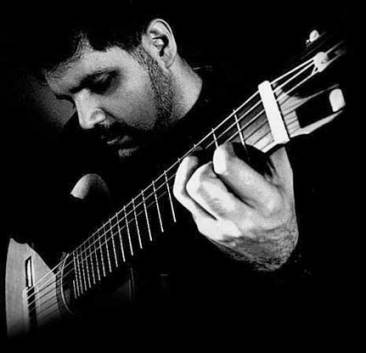
Ricardo CoboBut all that may be changing. A new generation of classical guitarists has emerged over the past decade, raising performance standards and pushing the instrument into new realms. These players have embraced the instrument's eclectic roots, while writing innovative works and digging up new repertoire.
"It's dawning on people that the classical guitar is not just a passing interest, that it's not the black sheep of the solo instruments," says Ricardo Cobo, whose recordings of little-known Latin American guitar music have met with global acclaim. "It's coming into its own, and it has an enormous following."
Cobo and more than a dozen top players of the new generation will be heading to Alexandria this week for nine days of concerts and master classes at the Alexandria Guitar Festival, which has grown from a quiet get-together into one of the most vibrant and thought-provoking musical events of the summer.
Young virtuosos such as Cobo, Kenneth Meyer, William Kanengiser (of the Grammy-winning Los Angeles Guitar Quartet), Lorenzo Micheli and Matteo Mela will be performing new works, giving master classes and exchanging ideas on the future of the guitar.
tight, predictable mold is being
broken" ...
"The festival's evolving very quickly," says Nathan Fischer, who started the event in 2002 after spending a summer accompanying the Alexandria Ballet and falling for the city's old world charm.
Initially set up as a way to bring high-level instruction to local guitarists, it now includes seminars, Suzuki training for young players and a forum for showcasing new talent from around the world. "We've always had high-quality players, but it's grown to include higher and higher-level artists," Fischer says.
The audiences are growing, too. Last year's concerts at the Old Presbyterian Meeting House were packed to the rafters, prompting a move this year to the roomier Masonic Temple. It's a sign, say the players, not just of the guitar's growing popularity but of the diversity of its fans, who include everyone from Bach lovers to banjo fanatics.
"The guitar draws classical listeners, but it transcends that because the guitar is used in every genre," says Meyer, head of the guitar studies program at Syracuse University. "So you get jazz and rock and folk musicians who are curious about what's going on. They want to get back to the roots."
Those roots go back centuries -- predecessors like the lute and the vihuela were favorites of the Renaissance -- but the modern, six-stringed guitar came into being only in the late 18th century. It flourished for the next four or five decades; Franz Schubert wrote many of his lieder on the guitar (often while lying in bed, according to legend), Hector Berlioz considered it his principal instrument and the great virtuoso Nicolo Paganini was said to be as accomplished on the guitar as he was on the violin.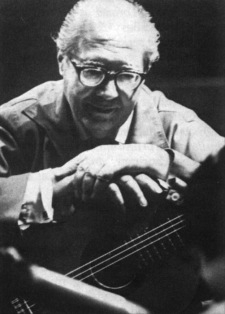
Andres SegoviaBut the guitar fell out of fashion later in the 19th century, and it wasn't until the 1920s that the Spanish guitarist Andrés Segovia almost single-handedly brought it back. Armed with a self-developed technique, transcriptions of Bach and an intuitive feel for the guitar's possibilities, Segovia battled his way onto the world's concert stages and established the guitar once again as a serious classical instrument.
His impact was immense; by the 1960s, music schools had begun to offer guitar programs (Baltimore's Peabody Conservatory was the first), and guitarists like Julian Bream, John Williams and Christopher Parkening were expanding on Segovia's pioneering work and commissioning important works from Benjamin Britten, Hans Werner Henze, Toru Takemitsu and other prominent composers of the day.
But some of today's players think it's time to move to the next level. "For many years Segovia was the captain of the team," Cobo says. "He set the repertory, he set the bar on performance and he made the guitar one more of the great classical solo instruments, to be played onstage like the violin or the piano. But that's not really the case anymore."
The guitar is a highly versatile instrument -- "it can be plugged in, or unplugged, you can use it in a computer setting," he notes -- and can be made of modern materials such as carbon fiber and Kevlar to make the sound project. Players like Cobo also find inspiration in the guitar's global reach: "It has roots in nearly every country in the developing world," he says. "The music of Brazil and Argentina really revolves around the guitar.
"So we're in a rare place, where all the music that was considered the bastard child of classical music is now at center stage. The tight, predictable mold is being broken."
As if to prove the point, Cobo will present some new works by little-known Cuban composers when he performs Wednesday night, Ken Meyer will be playing a new work for guitar and laptop, and non-classical players -- including flamenco guitarist Pedro Cortes and jazz guitarists Rick Whitehead and Bob Sneider -- also will be performing.
But most of the recitals will still focus on familiar guitar works by composers like Bach, Mauro Giuliani and Fernando Sor -- music that, for many, brings out the best qualities of the guitar.
"People love the subtleties of the guitar," Fischer says. "Segovia used to refer to the guitar as its own little orchestra, because of the tone possibilities, the coloring possibilities, the effects that you can do. It's as if you're being spoken to; there's something very intimate -- even captivating -- about the sound of the guitar."
Concerts at the Alexandria Guitar Festival take place every afternoon and evening from Wednesday to Saturday, and are held at the George Washington Masonic National Memorial in Alexandria. Tickets are available at Olsson's Books and Records, or online.
At the Sackler: Portugal's Haunted Empire
By Stephen Brookes • The Washington Post • June 24, 2007
___________________________________________________________________________________________________

© National Maritime Museum, LondonTo look at Henricus Martellus's 1490 map of the world is to behold a strange, unsettling planet. Europe seems vaguely familiar, but beyond the Mediterranean everything dissolves wildly into myth. Africa is a squarish blob, connected to Asia by a long strip of land. A huge island called Taprobana dominates the Indian Ocean, and there's no hint of the Americas or the Pacific Ocean; the map simply stops at China. Half the world is a confused jumble, and the other half is not yet even imagined.
But jump ahead a half-century to Pero Fernandes's map of 1545 -- and the planet is utterly transformed. A huge wave of exploration has brought the world into focus for the first time: Africa has taken on its distinctive shape, India is no longer an insignificant bump, the Pacific is there in all its vastness, and the Americas have appeared. Guesswork has given way to knowledge: A new world, with all its complexities and possibilities, has suddenly come into being.
culturalism" ...
The two maps -- works of art in themselves -- are part of a massive new exhibit opening today at the Sackler Gallery. Called "Encompassing the Globe: Portugal and the World in the 16th and 17th Centuries," it's a broad, impressionistic look at the trading empire built by the Portuguese that stretched from Brazil to Africa to Japan -- an empire that brought an explosion of knowledge to the Renaissance, fueled European expansionism and launched (for good or ill) the integration of the modern world.
"It's hard for us to imagine how transformatory this period was," says Julian Raby, the director of the Smithsonian's Sackler and Freer galleries. "It's the first moment of globalization -- information about the variety of the world, in terms of its peoples and cultures, was just pouring in. And part of what we want to get across is that sense of wonder at the complexities and textures of the world."
With roughly 275 objects on display, that shouldn't be a problem. "Encompassing" is the largest single exhibit in the Sackler's 20-year history -- taking up all its exhibition space and spilling over into the adjacent Museum of African Art -- and undoubtedly the most diverse. There are African ostrich eggs in ornate gold mounts, intricately carved crucifixes from Sri Lanka, a life-size oil painting of a Brazilian cannibal, Chinese astrolabes, Indonesian puppets, a Japanese shield covered in the skin of a ray, and a bewildering array of other wonders.
Yet, despite its global scope and almost runaway eclecticism, the exhibit is more than just souvenirs from a sprawling empire. "We looked for works of real aesthetic significance," says Jay Levenson, the show's guest curator, who scoured more than a hundred collections around the world to assemble the exhibit. "Works that told the story of the voyages, but that also documented the interchange among cultures."
For all that it changed the world, Portugal's empire remains largely unknown in America, overshadowed by the Spanish voyages to the New World. But the explorations that started in 1419 under Prince Henry the Navigator (particularly Vasco da Gama's opening up of a sea route around Africa in 1498) were at least as important, laying the foundations of global maritime trade and establishing an empire that endured until modern times; the last outpost, Macau, was only handed over to China in 1999.
But it was an unusual empire, designed not for conquest but for trade and, to a lesser degree, for spreading Christianity. The early voyages down the coast of Africa were aimed at breaking the Islamic world's monopoly on trade with the East, and forging an alliance with the mythical Prester John, a Christian king thought to rule somewhere in Africa. Using small, lightly armed flotillas of ships, the Portuguese established trading relationships rather than colonies. And as they ventured ever more deeply into Asia, they found themselves interacting not with the primitive world they'd expected but with complex, deeply embedded cultures and flourishing economies.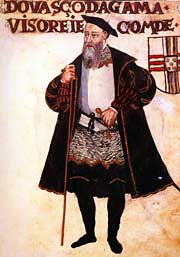 "It's much more about relationships between equals," says Levenson. "It's about trade and the exchange of knowledge."
"It's much more about relationships between equals," says Levenson. "It's about trade and the exchange of knowledge."
Empire-building of any kind is rarely a pretty business, though. And in fact, the Portuguese weren't out to foster greater understanding among the peoples of the world -- they were after control of the trading routes, and they were ruthless. Slave trading was rampant, uncooperative ports were bombarded, and piracy abounded. In one memorable episode, da Gama himself locked nearly 400 Muslims onto a ship and burned them alive -- including women and children.
"Many of the artworks were gained at a very high price," says Raby, "whether it was the death of indigenous peoples, through the diseases that were brought by Europeans, or by often quite violent encounters."
And in a sense, that's part of what makes "Encompassing" such a fascinating exhibit: It puts objects on display that reflect disturbing ambiguity more often than cheerful multiculturalism. Each of the encounters was different, but the artworks that resulted rarely show a free hybridization of cultures; many, in fact, almost seethe with tension.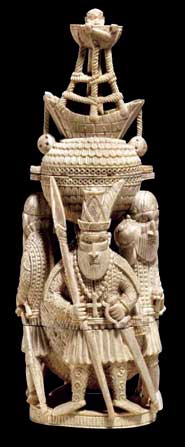 Take, for example, a remarkable ivory saltcellar from 16th-century Nigeria. Probably made as a trade item for European collectors, it's a beautiful, intricately carved piece that shows a group of Portuguese sailors (who would have been involved in the slave trade) supporting a ship. The sailors' faces are carved almost like African masks, and the ship's captain holds an African spear in one hand. The effect is charming -- until you notice the small, wide-eyed face peering out from inside the ship, and the objet d'art suddenly takes on a disturbing edge.
Take, for example, a remarkable ivory saltcellar from 16th-century Nigeria. Probably made as a trade item for European collectors, it's a beautiful, intricately carved piece that shows a group of Portuguese sailors (who would have been involved in the slave trade) supporting a ship. The sailors' faces are carved almost like African masks, and the ship's captain holds an African spear in one hand. The effect is charming -- until you notice the small, wide-eyed face peering out from inside the ship, and the objet d'art suddenly takes on a disturbing edge.
The complex relationships between the Portuguese and the cultures they encountered becomes even more apparent in the art from Asia, or "Estado da India," as the network of Portuguese enclaves throughout the region came to be known. Most of the outposts were small trading centers, designed to manage the lucrative spice trade. But Lisbon also held substantial territories, including Bombay and Goa, and where the Portuguese held physical control, they held cultural and religious dominance as well -- driven in part by Jesuit missionaries seeking converts.
"Goa in the 16th century was a territory of some hundreds of square miles, with maybe a million people," says Sanjay Subrahmanyam, a professor at UCLA and author of The Portuguese Empire in Asia, 1500-1700. "And there you're talking about forcible conversion, the destruction of Hindu temples, the elimination of the Muslim population."
It wasn't all conversion by force, but even so, the degree of Christian influence is striking in the exhibit's Indian artworks. Many are stunning; a 17th-century communion table from Gujarat mixes European and Indian styles with effortless grace, and an elaborate ivory carving with Christ as a lute-strumming shepherd draws deeply on Indian sculptural traditions; at first glance it could be taken for a work of Buddhist art.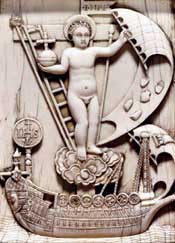 But a far more revealing work may be the ivory plaque that depicts the infant Jesus sailing one of the Portuguese trading ships. It's called "Young Christ as the Mariner on the Ship of Salvation," but the obvious ingratiation goes deeper than the title. The masterful Sri Lankan artist who carved it purged all traces of his culture from the work; it looks like something out of an Italian Renaissance workshop. As art, it's lovely. As an exercise in cultural self-abnegation, it's somewhat chilling.
But a far more revealing work may be the ivory plaque that depicts the infant Jesus sailing one of the Portuguese trading ships. It's called "Young Christ as the Mariner on the Ship of Salvation," but the obvious ingratiation goes deeper than the title. The masterful Sri Lankan artist who carved it purged all traces of his culture from the work; it looks like something out of an Italian Renaissance workshop. As art, it's lovely. As an exercise in cultural self-abnegation, it's somewhat chilling.
Other imperial tensions simmer throughout the exhibit, in remarkably different ways. In China, the Portuguese impact was so weak as to be almost undetectable; Beijing adopted Lisbon's superior astronomical knowledge but kept the rest at a studied distance.
In Japan, however, things turned disastrous. There the Portuguese initially met with success, winning some 150,000 converts to Christianity. But it quickly became their undoing; the ruling shoguns outlawed the religion, expelling missionaries and forcing suspected Japanese Christians to stamp their feet on bronze plaques bearing the face of Jesus -- known as fumi-e -- to prove their indifference.
It was only in Brazil, in fact (discovered virtually by accident by Pedro Alvares Cabral in 1500), that the Portuguese were able to build a large-scale colony as opposed to smaller outposts. Easily overcoming the indigenous Tupi people, Lisbon eventually set up huge sugar plantations, bringing hundreds of thousands of slaves over from Africa and, over the next few centuries, becoming the leader of the transatlantic slave trade.
Although that disturbing side of the empire is touched on only lightly, several paintings of Africans and Tupi by the 17th-century Dutch painter Albert Eckhout offer a gripping insight. Scaled to heroic size, the paintings were commissioned as "promotional literature" to encourage investment in the plantations, says the Sackler's Raby -- designed to show Europeans how native peoples benefited from the civilizing aspects of colonization.
And for all its multicultural aspirations, it's hard not to hear faint echoes of a similar spin in "Encompassing the Globe." Ever since its discoveries were celebrated by Luís Vaz de Camoes in his epic 16th-century poem "The Lusiads," Portugal's empire has been at the heart of its national identity, the rough edges softened and the myths massaged. Financed largely by Portugal's Ministry of Culture and dozens of Portuguese banks and corporations, "Encompassing" could be read as a paean to Portuguese imperialism, sheltering from hard questions in its own sheer vastness. But in the end, the artworks reveal a deeper and infinitely more satisfying story -- the tense, difficult and sometimes brutal birth of the modern world.
(To read this article in Portuguese, click here.)
"Four Angels" Takes Flight at NSO
Friday June 8, 2007
____________________________________________________________
"Four Angels" -- the new harp concerto by Mark Adamo that I wrote about last week -- had its premiere last night, and I'm sorely grieved that I had to miss it due to a badly strained back (the result of mixing bags of gravel with stupidity last weekend).
But the Post's Tim Page was there and calls it "ambitious, eloquent and often radiantly beautiful" and "a terrific addition to the literature." (Read the review here.) Performances again tonight and tomorrow at 8 pm.
Mark Adamo, Wild at Harp
Sunday June 3, 2007
___________________________________________________________
The Washington Post 6/3/07:
Mark Adamo is the fastest-rising new opera composer in the country, with back-to-back hits, a national PBS broadcast and major companies lining up to perform his work. So why is he back in Washington this week, not to wow the opera world but to premiere a decidedly non-operatic concerto for . . . the harp?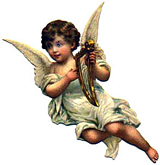 "Most writing for the harp is so trite!" says the composer, echoing a sentiment widely (if quietly) shared among music lovers. "We always hear this perfumed, elegant persona for the harp. It's Sunday morning brunch -- eggs Benedict with the harp strumming in the background. And the only thing more trite than that is all those insipid Christmas-card angels with which the harp is constantly associated.
"Most writing for the harp is so trite!" says the composer, echoing a sentiment widely (if quietly) shared among music lovers. "We always hear this perfumed, elegant persona for the harp. It's Sunday morning brunch -- eggs Benedict with the harp strumming in the background. And the only thing more trite than that is all those insipid Christmas-card angels with which the harp is constantly associated.
"So I decided," he says with a laugh from his studio in Upstate New York, "to kill two cliches with one stone."
And when it premieres on Thursday, "Four Angels" may set the harp world on its delicate ear. Five years in the making, it's an unbridled ride through the empyrean, portraying angels from Christianity, Islam, Judaism and Zoroastrianism not as simpering cherubim but as wild, passionate creatures. Released from its genteel prettiness -- and armed with unusual techniques such as pedal crashes and key glissandos -- the harp soars across a heaven-scape both terrifying and sublime, wreaking havoc and transcendence as it goes.
"It's like nothing that's ever been heard on the harp before; it's going to change the way people think," says Dotian Levalier, the National Symphony's principal harpist, who commissioned the work. "When we first talked about this, I told Mark that I didn't want another delicate, tinkly piece -- I wanted something with some meat behind it. And I think I got it."
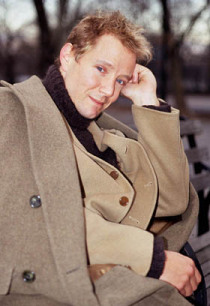
Photo by Martin GramFor Adamo, 45, the Kennedy Center premiere is a sort of debut -- it's his first concerto and his first major purely orchestral work. But it's also a homecoming. Adamo's career began in Washington when, as a composition student at Catholic University in the late 1980s, he struggled to make the rent and get his music heard.
Fortunately, he found a few angels of his own -- National Symphony Orchestra players Levalier, bassoonist Linda Harwell and Sylvia Alimena, a horn player who was then launching her now-acclaimed Eclipse Chamber Orchestra.
"I first met him when he was a waiter at the West End Cafe," says Alimena, referring to a restaurant just a few blocks from the Kennedy Center. "A bunch of us used to go there after National Symphony concerts, and we got to know him. At some point he asked us if we wouldn't mind playing one of his pieces, and I noticed how beautifully the wind parts and string parts were written. And I thought, this kid's kind of talented!"
Alimena was so impressed that she urged Adamo in the early 1990s to write a piece for her new orchestra. It was an offer that any young composer would have jumped at, but Adamo did not take it seriously at first. His real interest was musical theater, and despite being active in the local music scene -- singing in the Congressional Chorus, directing productions of light opera, and even writing music criticism for The Washington Post -- the idea of being a composer seemed almost absurd.
"I really only wanted to become overqualified as a theater songwriter -- that's why I was studying composition," he says. "Like a lot of people, I thought that unless you're Benjamin Britten and you've written five piano sonatas by the time you're 10, you're not going to be a composer."
But Alimena persisted, a deadline was set, and Adamo went to work. "I was having that year that people have, when all your friends start dying," he recalls. "I had an idea for an AIDS piece -- but to do a piece on that subject, of course, was heavy going. So I told Sylvia, 'I understand if it's not right for you.' And, God love her, she said, 'Just write what's in your heart.' "
The advice worked. "Late Victorians" -- an AIDS memorial for singer, speaker and orchestra -- premiered in 1995 to immediate critical and popular acclaim, and led to a commission from the Houston Grand Opera for a full-blown opera. Fully over his reluctance to consider himself a composer, Adamo wrote the lyrical, two-act "Little Women" (based on Louisa May Alcott's classic coming-of-age novel) and when it premiered in 1998, he joined the front ranks of American opera composers almost overnight.
The New York Times declared the opera a "masterpiece" and audiences responded to its humor, warm lyricism and fast, engaging flow. (Adamo, originally trained in theater, wrote the libretto himself.) In less than a decade, "Little Women" has been produced more than 40 times around the world, and in a rare coup for a maiden opera, was broadcast nationally in 2001 as part of the PBS "Great Performances" series.
With his career now officially meteoric, Adamo followed up with more successes -- notably the wildly funny 2005 opera "Lysistrata, or the Nude Goddess" (also written for the Houston Grand Opera). He became composer-in-residence for the New York City Opera (a post he held from 2001 to 2006), further refining a sophisticated, wide-ranging musical style that embraces everything from 12-tone modernism to Broadway show tunes, and even -- in the case of "Four Angels" -- the exotic sonorities of Chinese gongs.
That kind of eclecticism hasn't always impressed critics; Alex Ross, the classical music critic for the New Yorker, once praised his "dexterous synthesis of 20th-century techniques" while wondering if that's what the world really needs. But Adamo says that being flexible and using the vast global musical palette is the right -- maybe even the obligation -- of every contemporary composer.
"Why shouldn't I use the sound of Chinese gongs in a harp concerto?" he asks, railing against "the purity police" who demand that music fit into rigid categories.
"The history of concert music is one of almost unremitting ethnic war -- the French against the Italians, against the Germans, against . . ." He heaves a weary sigh in the direction of Europe. "But now, every nation is represented everywhere. We live in the world, rather than in one particular culture. For good or ill, it's a global village. And our challenge, artistically, is to make sense of all this incredible variety."
Adamo's now preparing a new opera for the San Francisco Opera; he won't disclose its subject yet, but says it will be "bigger and less fleet" than his previous works. He's also working on a collaboration with his partner of 12 years, composer John Corigliano, and is revising and recording many of his early works, several of which will be released on a Naxos recording next year by the Eclipse Chamber Orchestra.
As far as his angels are concerned, Adamo's rise has only just begun.
"My colleagues and I feel very strongly about Mark's music," says Alimena. "He's extremely brilliant, hysterically funny and rarely earthbound. But the important thing is that he's not afraid to sing. So many composers rely on percussion and loud noises. But Mark's not afraid to be lyrical, to show a tenderness in his writing. And I think that's why his music touches people so deeply -- and on so many levels."
The National Symphony Orchestra under Leonard Slatkin will perform Mark Adamo's Four Angels on June 7-9 at the Kennedy Center. The program also includes symphonies by Haydn and Mahler.

